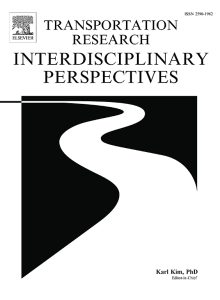Unequal relational travel patterns of long-distance rail trips between different levels of settlement hierarchies – Case study from Hungary
Vilmos Oszter, István Kövesdi, László Sipos
Transportation Research Interdisciplinary Perspectives – Volume 31, May 2025
Highlights
- Use of the novel Sum of Ranking Differences multicriteria decision-making method in rail transport.
- Through the study of long-distance rail links, the Hungarian urban network structure is better revealed.
- Over 80% of the total long-distance rail trips are capital city related in Hungary.
- Leisure and family related long-distance travel turned to be more heterogeneous than work or education purposes.
- One of the highest deviations from the average interurban work rail trips is for trips between Budapest and regional cities.
Abstract
The study of long-distance travel behaviour has become a prominent field of research on a global scale. Parallel with economic development, the proportion of long-distance trips undertaken by individuals and groups across the globe is increasing. Based on a countrywide on-board passenger survey conducted among passenger rail users in one of the highest railway modal-share member states of the European Union, Hungary, significant differences have been revealed by novel interdisciplinary statistical methods. Passengers were voluntarily asked about their actual trip characteristics and their basic socio-economic background. Origin and Destination (OD) trip settlements were classified into specific settlement hierarchy groups and by the novel Sum of Ranking Differences (SRD) algorithm and ANOVA, the multiple surveyed socio-economic trip characteristics were grouped.
The results confirm that a higher level of settlement network hierarchies generates overall more though not necessarily more frequent long-distance trips, which are not equal to all sub-categories. The analysed three most frequent travel purposes (work, education, other) show significant variation between the different OD pairs. Long-distance work and education trips are more homogeneous in comparison with leisure and visiting friends and relatives’ trips. In all trip purpose categories, lower settlement hierarchy level connections demonstrated different travel patterns. The challenging socio-economic conditions in rural areas require improved travel conditions that are spatially and socially balanced. When deciding about costly timetable-oriented infrastructure developments, policy makers and transport organisers must consider all kinds of needs. The revealed unequal OD trip patterns call for policy recommendations for the respective spatial and transport planning authorities.
Keywords: Sum of ranking differences (SRD), Rail transport, Travel behaviour, Settlement network, Urban systems, Travel survey




